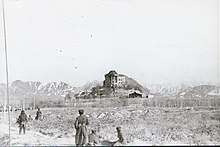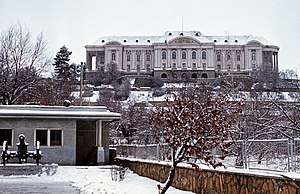Operation Storm-333
Operation Storm-333 (Russian: Шторм-333, romanized: Shtorm-333) was a special operation that took place on 27 December 1979, in which Soviet forces stormed the Tajbeg Palace in Afghanistan and assassinated Afghan President Hafizullah Amin. Tajbeg Palace was guarded by Afghan National Army.[1] In the ensuing battle, Afghan armed forces suffered major losses.[3] 30 Afghan palace guards were killed while 150 were captured.[4] Amin's 11-year-old son died from shrapnel wounds.[5] A total of 1,700 Afghan soldiers surrendered to Soviet troops and were taken as prisoners.[3] The Soviets installed Babrak Karmal as Amin's successor.
Several other government buildings were seized during the operation, including the Ministry of Interior building, the Internal Security (KHAD) building, and the General Staff building (Darul Aman Palace). Alpha Group veterans call this operation one of the most successful in the group's history. Declassified Russian documents show that the Soviet leadership believed that Amin had secret contacts with the US embassy and was probably a US agent.[6][7] However, this assumption was later proven to be false.[8][9]
Background
The Democratic Republic of Afghanistan was initially led by Nur Muhammad Taraki, who was pro-Soviet Union, which resulted in cordial Afghan–Soviet relations. In September 1979, Taraki was deposed by Hafizullah Amin, due to intra-party strife. After this event and the suspicious death of Taraki (an apparent assassination by Amin's orders), Afghan–Soviet relations started to deteriorate; by December the Soviet leadership had established an alliance with Babrak Karmal.[10] The Soviet Union declared its plan to intervene in Afghanistan on 12 December 1979, and the Soviet leadership initiated Operation Storm-333 (the first phase of the intervention) on 27 December 1979.[11]
Soviet forces
Storm-333 was part of a bigger operation Baikal-79 aimed at taking control over ca. 20 key strongholds in and around Kabul, which included major military headquarters, communication centers and jails.[12]
The core of Storm-333 assault team included 25 men from the Гром (Grom – "Thunder") unit of Alpha Group, and 30 operators from a special KGB group Зенит (Zenit – "Zenith"), later known as Vympel and Гром (Grom - "Thunder"). There were also 87 troops of a company of the 345th Independent Guards Airborne Regiment.[13] 520 men from the 154th Separate Spetsnaz Detachment of the USSR Ministry of Defence known as the "Muslim Battalion" because it consisted exclusively of soldiers from the southern republics of the USSR. This motorized rifle battalion had been formed in the USSR earlier in 1979 at the specific request of the Afghan President to guard his residence as he could not rely on Afghan troops.[12] These support troops were not issued armor or helmets, but one of them recalls that a magazine tucked inside his clothes protected him from an SMG bullet.
Palace assault and death of Amin

The assault on the Tajbeg Palace, where President Amin was in residence with his family at the suggestion of his KGB security advisers, took place around 7 p.m. on 27 December 1979.[12][14] The Tajbeg Palace was guarded by Afghan National Army.[1]
During the attack, Amin still believed the Soviet Union was on his side, and told his adjutant, "The Soviets will help us".[15] The adjutant replied that it was the Soviets who were attacking them; Amin initially replied that this was a lie. Only after he tried but failed to contact the Chief of the General Staff, he muttered, "I guessed it. It's all true".[16] He was captured alive by Grom troops, but semi-conscious, suffering convulsions due to interrupted medical treatment of the poisoning.[17] The exact details of his later death have never been confirmed by any eye witness. The official announcement of his death on Kabul Radio, as reported by the New York Times on 27 December 1979, was "Amin had been sentenced to death at a revolutionary trial for crimes against the state and that sentence had been carried out". One story at the time was Amin was killed by Sayed Mohammad Gulabzoy, a previous Minister of Communication until ousted by Amin, who was present with two other previous ministers during the assault to give credence it was an Afghan-controlled operation. Gulabzoy and Watanjar, the previous Minister for Defense, later confirmed his death. This story of his death after a summary trial is supported by the fate of Amin supporters who a 'Revolutionary Troika' arrested and sentenced to death, were executed on the spot with a bullet in the back of the neck.[18] Amin's son was fatally wounded and died shortly after.[16] Amin's daughter was wounded, but survived.[19] 348 other Afghans, including 30 of Amin's most personal guards from Palace and Presidential guards, also died in the fighting, and part of the palace went up in flames. 150 of the 180 Palace and Presidential guards, who were regular troops, surrendered when they realized the attacking troops were from the USSR, not from an Afghan unit.[17] A total of 1,700 Afghan soldiers surrender to Soviet troops and they were taken as prisoners.[3] Main part of the operation was completed within 40 minutes.[12]
Soviet losses
During the assault on the Tajbeg 5 officers of the KGB special forces, 7 troops from the "Muslim Battalion", and 2 paratroopers were killed. The commander of the KGB contingent, Col. Boyarinov, was killed. All the surviving participants in the KGB troops in the operation were wounded. Also, Soviet army doctor Colonel V.P. Kuznechenkov who was treating President Amin was killed by friendly fire in the palace, and was posthumously awarded the Order of the Red Banner.[20]
Memoirs of the participants
According to Oleg Balashov, who was second in command of the assault group, the group was led by two elite units of Alpha and Vympel (15–20 each). The Alpha group targeted Amin, and the Vympel group had the task of collecting factual evidence that Amin was collaborating with the United States. Both groups were brought to Afghanistan secretly and blended with Muslim Battalions to make an impression that the operation was carried out by local units, whereas in reality nearly all work was done by Alpha and Vympel.[21]
Before the operation, Balashov surveyed the area under the guise of a bodyguard of a Soviet diplomat. His unit knew that they were going to a death zone and felt uncomfortable about it – about 80% of them were wounded shortly after they left their vehicles, yet they continued the assault. As Balashov expected, Amin's troops targeted the first and last vehicle in the convoy of six. He placed his team of five men in the front BMP and, when the BMP got immobilized by fire from Amin's troops, ordered them to abandon the BMP and run to the palace. All five were quickly wounded by intensive fire from the guards, but were saved by bulletproof vests and helmets.[21]
This account generally agrees with that by Lyakhovskiy, who gives more details and accentuates the ferocity and professionalism on both the attacking and defending sides.[22]
See also
- Operation Neptune Spear
References
- Michael Newton (17 April 2014). Famous Assassinations in World History: An Encyclopedia. ABC-CLIO. p. 17.
- Peter Tomsen (9 June 2011). Wars of Afghanistan (1st ed.). PublicAffairs. p. 174. ISBN 978-1586487638.
- Lester W. Grau. "The Take-Down of Kabul: An Effective Coup de Main". Global Security. Retrieved 7 December 2018.
- Martin McCauley (2008). Russia, America and the Cold War: 1949–1991 (Revised 2nd ed.). Harlow, UK: Pearson Education.
- "How Soviet troops stormed Kabul palace". BBC. 27 December 2009. Retrieved 1 July 2013.
- John K. Cooley (2002) Unholy Wars. Pluto Press. p. 8. ISBN 978-0745319179
- "Context of 'July 3, 1979: President Carter Approves Covert Aid to Anti-Soviet Forces in Afghanistan'". History Commons. Retrieved 2018-12-18.
- James G. Blight (2012). Becoming Enemies: U.S.-Iran Relations and the Iran-Iraq War, 1979-1988. Rowman & Littlefield Publishers. p. 70. ISBN 978-1-4422-0830-8.
- Seth G. Jones (2010). In the Graveyard of Empires: America's War in Afghanistan. W. W. Norton & Company. pp. 16–17. ISBN 9780393071429.
'It was total nonsense,' said the CIA's Graham Fuller. 'I would have been thrilled to have those kinds of contacts with Amin, but they didn't exist.'
- Angelo Rasanayagam (2005). Afghanistan: A Modern History. I.B.Tauris. p. 90. ISBN 978-1850438571.
- Camp, Dick (2012). Boots on the Ground: The Fight to Liberate Afghanistan from Al-Qaeda and the Taliban, 2001–2002. Zenith Imprint. pp. 12–13. ISBN 978-0-7603-4111-7.
- Dmitri Volin (25 December 2019) Участник штурма дворца Амина: мы шли под прямой автоматный огонь. tass.ru.
- Vadim Udmantsev (29 December 2004) Боевое крещение "мусульман". VPK-news.ru (in Russian)
- Braithwaite 2011, p. 96.
- Braithwaite 2011, p. 98.
- Braithwaite 2011, p. 99.
- Aleksandr Lyakhovskiy (January 2007). "Inside the Soviet Invasion of Afghanistan and the Seizure of Kabul, December 1979" (PDF). Woodrow Wilson International Center for Scholars. Archived from the original (PDF) on 2007-09-26. Retrieved 2007-09-25.
- Braithwaite 2011.
- Braithwaite 2011, p. 104.
- Peter Tomsen (9 June 2011). Wars of Afghanistan (1st ed.). PublicAffairs. p. 174. ISBN 978-1586487638.
- Interview with Colonel Oleg Balashov. BBC (in Russian)
- A. A. Lyakhovskiy Декабрь, день27, 1979. orc.ru. This page refers to Alpha and Vympel by their previous names Grom and Zenith, respectively
Bibliography
- Braithwaite, Rodric (2011). Afgantsy: The Russians in Afghanistan 1979–89. Profile Books. ISBN 978-1-84668-062-5.CS1 maint: ref=harv (link)
- Mitrokhin, Vasiliy (July 2002). "The KGB in Afghanistan" (PDF). Woodrow Wilson International Center for Scholars. Archived from the original (PDF) on 2017-12-28. Retrieved 2011-12-16.
- Grau, Lester. "The Takedown of Kabul: An Effective Coup de Main". GlobalSecurity.org. Retrieved 2007-09-25.
